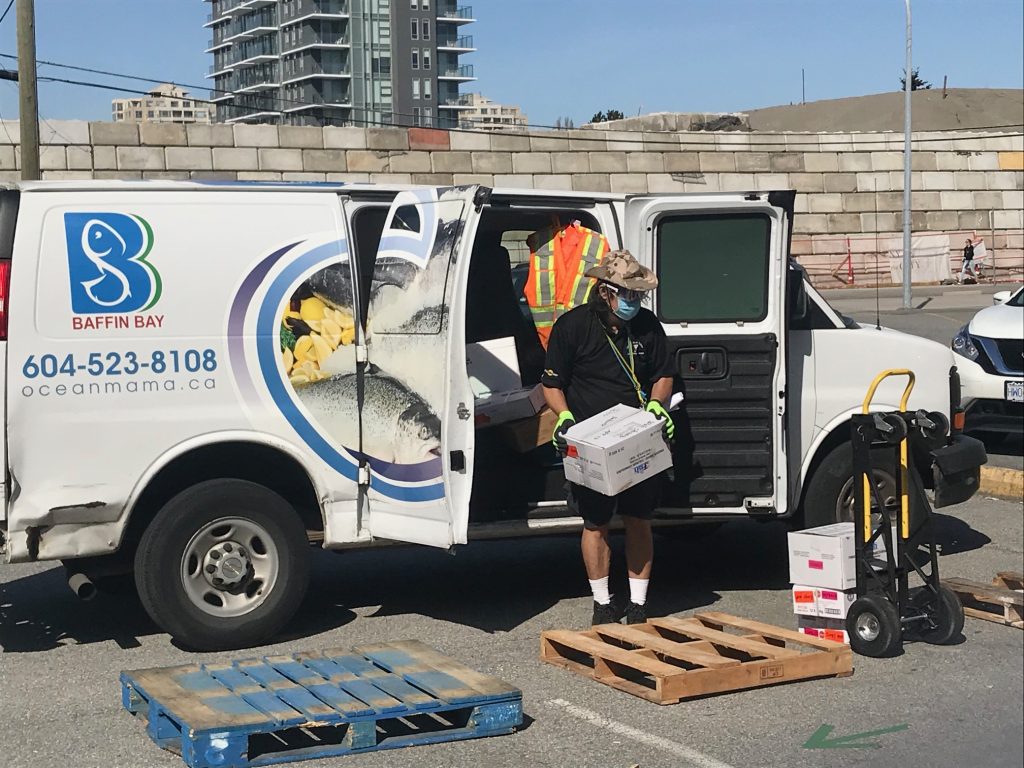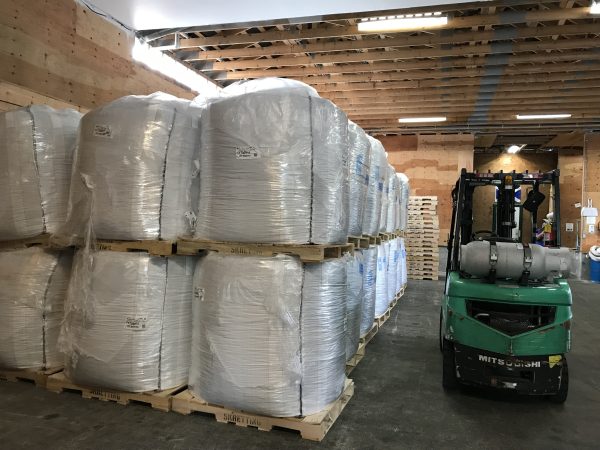
Supply chain gridlock brings headwinds to aquaculture
November 18, 2021
By
Liza Mayer
Strengthens case for North American industry’s expansion
 Delivery man unloads boxes of seafood at a Vancouver, BC supermarket. The disruption in the supply chain is making the case for expanding local supply, say industry sources. (Photo: Liza Mayer)
Delivery man unloads boxes of seafood at a Vancouver, BC supermarket. The disruption in the supply chain is making the case for expanding local supply, say industry sources. (Photo: Liza Mayer) Players in North American aquaculture are reporting the supply chain crisis is affecting operations, from increased logistics costs to raw material shortages, making a stronger case for domestic aquaculture and a local ecosystem to support it.
Increasingly frequent shipment delays on containers, escalating costs of fuel, warehousing and raw materials threaten the industry’s ability to deliver products and services, profitability and growth.
Canadian seafood producers on both coasts truck the bulk of the salmon production into the United States, somehow sparing them from port-congestion problems, at least for now.
“Currently, there are no supply chain interruptions with market delivery on either Canadian coasts,” says Ian Roberts, director of communications at Mowi for Scotland, Ireland and Canada.
Farmers are not entirely off the hook, however.
“Because most of the elements of supply chain both upstream and downstream of our operations are contained within North America, there is very little disruption to schedules. However, worldwide transportation problems do affect some costs, for example fuel costs,” says Rocky Boschman, managing director, Grieg Seafood BC.
Impact on feed
“Fuel prices have nearly doubled over the same period last year,” says Brad Rude, regional risk management and sourcing director at animal nutrition specialist, Cargill. “Container prices have skyrocketed, in some cases five times or more than historical normal and streamlining of shipping routes has cut movement to smaller ports. In the aquafeed business in particular, we are no longer able to ship South American ingredients directly to port in Vancouver (because of the congestion).”
He said the availability of critical specialty ingredients, such as vitamins, amino acids, fishmeal and fish oils, has been very challenging and they have been difficult to replace with alternatives.
“Normally upcycled byproducts of meat processing, like meat meals, have also been challenging. In general, all ingredients that have to ship long distances are affected to a varying degree,” he says.
The mounting costs arising from the supply chain disruption make fish farmers vulnerable to potential increases in prices of feed, which already account for at least half of production costs.
“Raw material prices have been high for over a year now and are expected to remain so in the coming period. Sea logistics have become very expensive; five to six times, compared to 2019 prices, unreliable and with limited availability,” said Robert van den Breemer, procurement director at Skretting.
Brad Hicks, a partner at Taplow Feeds of British Columbia, says suppliers of feed raw materials are losing the ability to buffer the effects of supply and demand on pricing. Whereas ingredient suppliers used to be able to re-direct supply toward regions with limited supplies – thus, keeping prices in check – this is less and less the case, he says.
“With the increasing severity of ocean freight congestion, the ability to buffer the supply/demand equation is being hampered, resulting in increased pressure on prices for some ingredients locally.”
For Virginia-based Blue Ridge Aquaculture, the delivery of raw materials is the biggest concern. The company, known as the world’s largest producer of indoor-raised tilapia, started making its own feeds in 2017 in order to save an estimated 25 per cent in feed costs per year.
“The challenge is making sure our domestic suppliers have the ability to deliver. Because of these concerns, we have increased the amount of raw material inventory we keep on hand,” said Martin Gardner, vice-president of business development.

Salmon feed inventory at a BC farm. Supply chain bottlenecks are impacting the availability of critical specialty ingredients for feed. (Photo: Liza Mayer)
Impact on equipment suppliers
Aquaculture equipment manufacturers are also feeling the sting of the supply chain bottlenecks. Delivery times for new equipment or parts are being stretched, causing major headaches for farmers.
“We do not have any issues with selling our oysters but we have had delays in ordering equipment parts. The cost of everything has risen, which increases expenses. In the event that we need major parts to continue to operate, those could set us back if the wait times are extensive,” said Greg Martino, co-founder of Cottage City Oysters on Martha’s Vineyard.
Technology and equipment firm ScaleAQ North America acknowledged parts deliveries are getting delayed.
“It is slowing down our servicing of cameras for returning them to operation, we are hampered in shipments from Chile – stopping at many ports along the way with long queues to offload/pick up. We are seeing extremely long lead times on all orders which means that some biological deadlines for fish are not met,” said Genny West, general manager.
“We are having to tell our customers to expect very long lead times. We are having to revamp the way we plan our inventory and start carrying much more inventory, which is expensive. We are not able to secure parts we need, when we need them.”
Local strategy
Gardner of Blue Ridge Aquaculture says the disruptions in the industry have exposed the fragility of global supply chains and makes the case for expanding local supply.
By value, the United States imports approximately 90 per cent of the seafood consumed domestically.
“This validates the need for the US seafood model to transition to domestic supply. We have always believed that the US should supply its own seafood, and have been positioning our company as a solution to this problem,” said Gardner.
“We can do this, and we must,” says Jeanne McKnight, executive director, Northwest Aquaculture Alliance.
“As we learned during the pandemic, when much-needed seafood supplies were halted at the border, the United States absolutely must – state by state and at the federal level – commit to building a thriving Blue Economy that includes aquaculture, the farming of finfish and shellfish as well as sea vegetables,” she says.
“This means tapping into our natural resources and technical know-how to create the necessary frameworks that investors seek, and companies need: the right to farm finfish and shellfish, a guarantee of dedicated space in which to farm, and the authorization to do so.”
Hudson Valley Fisheries CEO Paul Wong says a local strategy makes a lot of sense especially during these times.
“Our RAS operation allows us to operate our farm close to demand. So far no delays in bringing products to market. But if the supply chain continues to deteriorate, in the end, we may experience issues at the supply side, such as feed supply. But so far, we have not experienced such issues.”
Experts appear to have reached a consensus that the bottlenecks will take time to resolve. Gardner of Blue Ridge Aquaculture shares the view.
“We are certain the disruptions will continue, the question is how long will they last,” he says, nor does he expect “a sudden end to COVID.”
“The effects will linger in the short term. Our sales in 2021 are on par with 2019, and pricing has been consistent. We do anticipate that US consumers will have a higher preference for domestic/fresh products with lower food miles, and we are positioning ourselves to meet that shift.”
Positioning to meet rising demand means expanding operations, but again, worries over the availability and delivery of much needed supplies cloud those plans. “Our concerns are in respect to building materials and equipment for new capital projects,” says Gardner.
Wong of Hudson Valley Fisheries adds: “The deteriorating supply chain will hurt the recovery of the overall economy that we are part of. However, we will continue to enjoy the benefit of being local as we see buying local as a sustainable growth trend.”
Opportunities for innovation
The situation has presented the industry the opportunity to rethink their supply chains. Many are developing relationships with local sources so they are able to deal better with similar predicaments in the future.
“We, as a global company, are being as pro-active as possible by adding new supplier contracts and trying to plan ahead as much as possible,” says West of ScaleAQ.
“Our supply chain managers are looking to source items locally – steering away from Asia as much as possible to, ideally, as close to the end user as possible, i.e. here in Canada. We are building up our inventory, we are writing letters to our customers warning them of the delays and are securing orders with our raw material suppliers prior to orders arriving.”
Many are streamlining operations to become more efficient.
“We have made efforts to simplify our incoming supply chain by using alternative ingredients that come from North American origins that can be sent to us with a more reliable and forecastable transit method and lead time,” says Rude of Cargill.
“We can’t predict what will happen, but we have a long history of helping our farmers and customers successfully manage risk, no matter the challenge.”
At Skretting, continuous connection and collaboration between operations, procurement, formulation, quality assurance and sales continues so that it can formulate diets tailored to customer needs with the available raw materials, it said.
“Nowadays that (raw materials) is unfortunately not always the same as desired. This is not easy, but we are a very strong team with great connections which means we can overcome the challenges,” says van den Breemer, adding that despite major market turbulence and shortages in several ingredients, it has been able to meet the demand of our customers in North America, and for all global Skretting customers.
As the pandemic has done, the supply chain is testing the industry’s resilience. In the end, the ingenuity and innovations would boost its agility.
Advertisement
- Biological issues in Canada impact Mowi’s bottom line
- Why Nordic Aquafarms is unfazed by project delay





